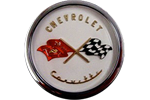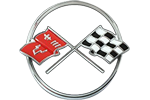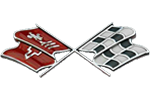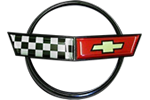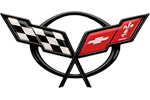Vette Doctors Featured in Corvette Magazine: Nuclear Proliferation
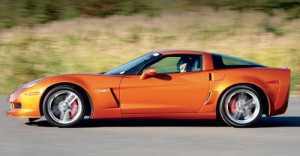
Vette Doctors Featured in Corvette Magazine: Nuclear Proliferation
The first-time Corvette owner got bit by the Z06 bug when he drove an ’04 C5 version from Pennsylvania to New York for his father, who had just purchased it used. Knowing the new, C6 version was coming out soon, Balducci bid his time and saved his money. He missed the first year of production, but placed an early order for an ’07 model. Since most of the ’06 Z06s he’d seen were yellow, Balducci ordered an Atomic Orange one, sight unseen. “When I placed the order, the car was being built in two weeks and I kept nagging my wife whether this was a good choice or not,” he recalls. “We decided to stay with it. The day we showed up at the dealer and I saw the car, I knew we’d the right decision.”
Balducci may have been happy with his paint choice, but as already mentioned, he quickly lusted after more engine output. He also wasn’t entirely pleased with the cockpit, either. “The interior of a stock Corvette is not up to my standard, ”he says. “I wanted it to match my Range Rover.” Balducci also admits he was looking for a new project to tackle: He’d already transformed his ’93 Chevy 454SS pickup truck into a supercharged Pro Street drag machine.
The first call was to Vette Doctors in neighboring Amityville, New York. Balducci soon worked out a custom engine upgrade catered to his specifications. Knowing that he’d be putting a lot more power to the pavement and not being entirely happy with the stock Corvette’s handling, Balducci also sketched out a thorough suspension upgrade. In March of 2008, he brought his Z06 to Vette Doctors; three months and $13,000 later, he drove home with a distinctly better-performing machine.
Engine Work
As with most engine upgrades, the aim of Balducci’s build was to allow the LS7 to take in more air and discharge spent gases more quickly, but instead of just attacking the intake and exhaust systems, Vette Doctors opened up this small-block V8’s heart. Out came the stock camshaft, in went an RX Sick Stick II. The heads were removed for milling work; when they went back in, they were wearing uprated springs and push rods. The pistons were modified to increase the compression ratio from 11.0:1 to a lofty 12.2:1. A Callaway airbox was paired with a 160-degree thermostat on the intake side, while American Racing headers, high-flow cats and mufflers handle the exhaust.
A conservative pull on Vette Doctor’s chassis dyno—remember, the car still had less than 1,000 miles on the odometer—resulted in 565 horsepower and 515 lbs-ft of torque at the rear wheels. Assuming driveline losses of 15 percent, that’s a 135-horsepower boost over the stock powerplant.
During its stay in Amityville, the Z06 was also given its suspension treatment. The stock leaf spring and shocks were removed and replaced with Pfadt adjustable coil-over dampers. Pfadt also got the nod when it came to the front and rear anti-roll bars. The brakes were left as-is, but the gearbox received a Kirban short-shift kit.
Orange Crush
When it comes to the Corvette’s aesthetic mods, it is clear that Balducci is a fervent admirer of Atomic Orange paint. The front spoiler was removed and painted that bright hue, as were nearly all of the black exterior trim pieces.
The nuclear color has also spread to the cockpit. Large swaths of the instrument panel and center console have been painted Atomic Orange, as have the top cap on the shifter, the parking-brake button and even the door release surrounds. Since our photo shoot, Balducci has added more orange items, all from DSVettes. “I was at a car show in Atlantic City and Geraldo [Astorga], the [DSVettes] owner, was there,” he says. “We started speaking about my Vette and he showed me the first Atomic Orange steering wheel they created—after negotiating a deal, it was mine.”
Balducci then proceeded to order leather upholstery items from DSVettes, including a Jake-themed center-armrest cover, transmission-tunnel covers and door panels—all with orange stitching that contrasts sharply with the black leather.
Pop Goes the Piston
Despite the color-matched interior bits and the engine’s shiny chrome valve covers, this Z06 is no mere show car; Balducci drives it, and drives it hard. During a charity event on a closed highway, he cracked the 200-mph barrier on several occasions. Unfortunately, on his last 12-mile run, during which he reached a terminal velocity of 205 mph, the engine let go. “The car was running flawlessly the whole time, speeds between 150 and 200 mph,” says Balducci. “Temperature, oil pressure—everything was all good. Then, suddenly, the head-up display read ‘engine power loss.’ As I started to pull over, I could see white smoke in my rearview.” As it turned out, his #7 piston was toast.
While it would be reasonable to assume that a cammed-up engine with raised compression is more likely to burst a seam than a stock one, Balducci isn’t so sure. “I don’t think it was a result of the run, but rather that GM allowed this weak link in the motor,” he claims. “After looking into this and speaking to other Z06 owners on the Corvette Forum, it seems that this #7 piston is blowing on many LS7s, even stock ones. I’m not 100-percent ruling out that my performance parts may have contributed to it. It may have been old, stale gas, too.”
In April 2009, with the car’s odometer reading 2,967 miles, Balducci returned his Corvette to Vette Doctors—not to complain, but to get prescribed an even stronger, more powerful engine. As his reasoning goes, “If you wanna play, be prepared to pay.” And that he was, because this time Balducci ordered a more thoroughly upgraded engine. “I wanted to build this motor with all the best, strongest and most reliable parts,” he says.
Vette Doctors’ first step was to remove the engine and strip it down, including the removal of the cylinder liners. It was at this point that the broken #7 piston was discovered, as well as a cracked cylinder wall. New liners were installed, and then machined in preparation for a set of slightly larger forged Wisco pistons. The overbore would expand the displacement from 427 to 434 cubic inches. The rebuild included a Callies crankshaft and Compstar rods, and to make sure everything was buttoned down tight, ARP main studs and head bolts were used.
Bowever, Balducci had by no means ordered a conservative engine. The Sick Stick II camshaft was swapped for Vette Doctors’ even hotter Sick Stick III grind. While replacing all the valves and springs was done as a precaution, bolting on an NEX nitrous-oxide system definitely was not. The switches for this 100-shot power booster are neatly concealed inside the ashtray. The exhaust system was retained, but a larger FAST 102 intake manifold was needed to keep up with the requirements of the heavy-breathing motor.
Balducci didn’t get his Z06 back until the end of January. It may have been in the shop nine months, but the actual work only took about two. This was the result of Vette Doctors being busy and Balducci taking time to decide exactly what he wanted—not an easy task considering the wide range of options. “The nitrous was a last-minute decision,” he says. In the end, the engine work set him back a heady $23,500. In return, he got a Z06 with an estimated 625 horsepower at the rear wheels—that’s before unleashing the juice. With that in mind, Balducci’s goal of achieving an output of 700 horsepower appears well in hand. Once the engine is fully broken in, a dyno test will hopefully confirm that fact.
Proof in the Pudding
Dyno sheet or no, this Corvette is brutally fast. “As soon as the vehicle starts, not only do you hear the rumble of the cam, you can feel it—the fenders shake,” says Balducci. “Once the clutch engages, you feel the power. After 3,500 rpm, it just becomes a beast, the sound is something very distinct—my wife says it sounds like steel breaking. Makes those fine-tuned Lamborghinis sound stale.”
Translating all those naturally aspirated ponies into forward movement can be a little tricky. “It gets loose in the first three gears,” says Balducci. “It takes total concentration and an experienced driver to handle all that power. It’s like trying to tame a wild animal.”
Initially, Balducci was concerned that the Corvette wouldn’t be as fast as his other wild animal, the Pro Street pickup, which happens to have a blown 502-cubic-inch V8. “I wasn’t sure that the Vette would feel even more powerful than that truck, which has tons of torque,”?he says. “But the doctors did their job and that Vette pulls harder than any other vehicle that I’ve ever been in. Even at speeds of 150 mph, it still pulls hard.” All these comments are based on standard gasoline, not the nitrous-oxide enriched variety, flowing through the engine.
Balducci is also very pleased with how the car goes around corners. “It handles like it’s on rails,” he says. “The suspension keeps the car planted to the ground. When it was stock, it was a little scary at higher speeds; the rear end would skip around. This is how the Z06 should have come stock from the factory.”
While Balducci admits that some ride quality was lost as a result of the stiffer springs, he says that the Z06 is still very streetable. “My wife and I have gone on two-hour rides and we’ve had no discomfort issues,” he says, quickly adding, “I’ve been lucky to have the full support and encouragement from my wife on everything I’ve done, and even plan to do, to the Vette.”
Wait, plan to do? Balducci isn’t done yet? As with most project cars, this Z06 is destined to be an eternal work in progress. There are some more finishing details he wants to add to the dashboard, and he’s eyeing some new rims. Then there are the racing seats, harnesses and roll bar he’s considering adding. Getting the car on track is definitely part of the plan.
One thing he doesn’t plan to do is sell the Corvette anytime soon; he’s definitely not grown tired of it. “I’ve had this car for four and a half years, and I still feel that adrenaline rush each time I get in,” Balducci says. Plus there is the fact that his 8-year-old son already has designs on it.


